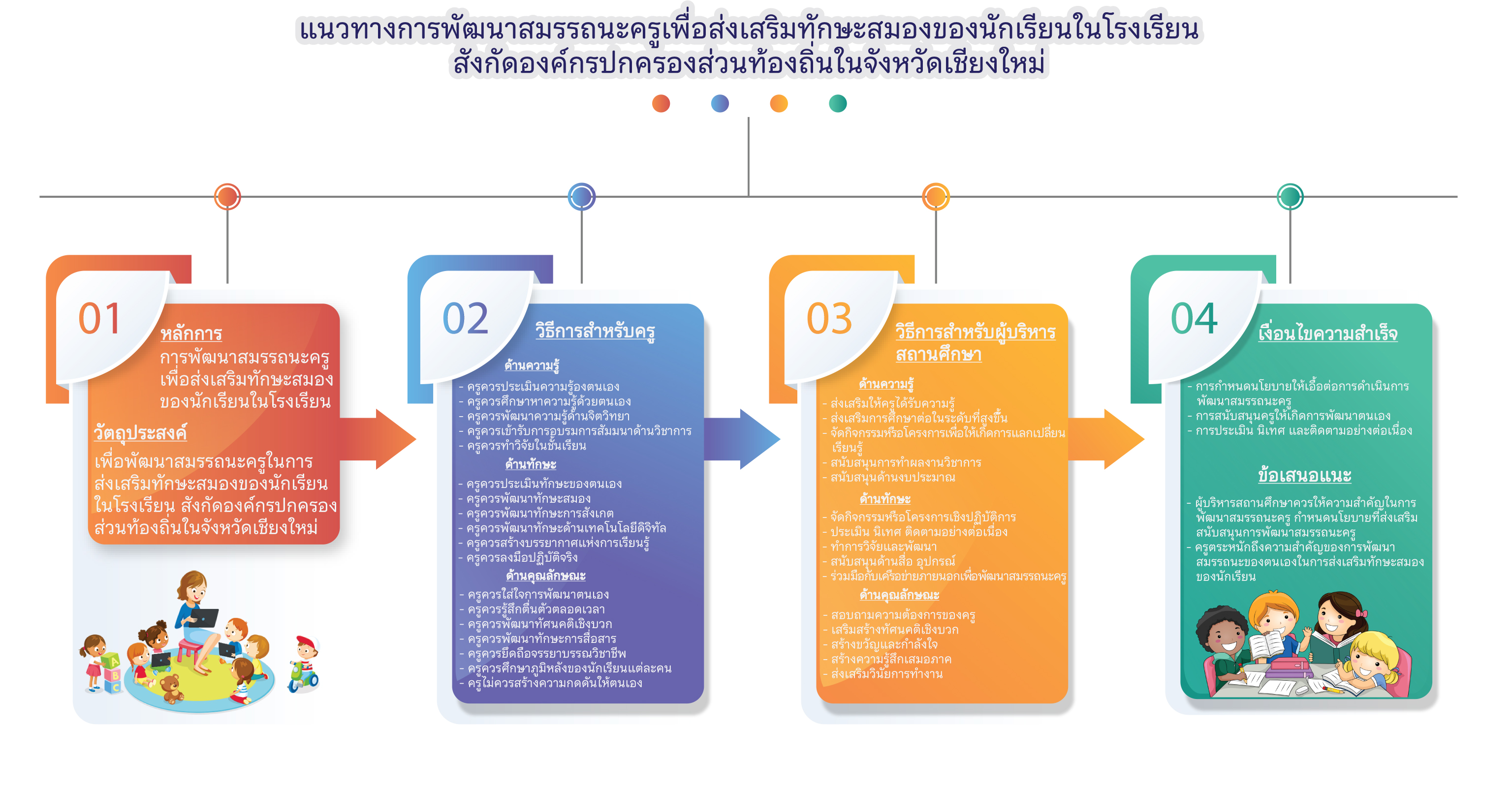Guidelines for Teacher Competency Development to Promote Executive Functions of Students in Schools Attached to the Local Government Organization in Chiang Mai Province
Main Article Content
Abstract
The purposes of this research were: 1) to study the current and the desirable states of the teacher competency to promote executive functions of students. 2) to develop guidelines for the teacher competency to promote executive functions of students., and 3) to assess the feasibility and suitability of the guidelines for the teacher competency to promote executive functions of students in school attached to the local government organization in Chiang Mai province. A study has been carried out with Mixed Methods Research. Proceed with three steps according to the objective. The data providers were teachers in schools under the local government organization in Chiang Mai province in the academic year 2023, 243 participants, experts in educational administration, educational institution administration, and promoting executive functions, with a total of 9 experts, and 5 experts. The tool used were the questionnaire and the interview form. Data were analyzed by using means, standard deviations, the Priority Needs Index (PNI modified), and Content analysis.
The results revealed that:
1. The current state of the teacher competency to promote executive functions of students was overall at a high level, and the desirable states was overall at a highest level. The component with the highest needs was Knowledge, followed by Skills and Attributes.
2. Guidelines for the teacher competency to promote executive functions of students should address five key aspects: (1) The principle for developing the teacher competency to promote executive functions of students. (2) The objective for developing the teacher competency to promote executive functions of students in school attached to the local government organization in Chiang Mai province. (3) The process of developing the teacher competency for teachers and educational administrator as Knowledge, Skills and Attributes. (4) The success conditions., and (5) Additional suggestions.
3. The feasibility and suitability of the guidelines for the teacher competency to promote executive functions of students overall at a highest level with an average of 4.79 and 4.52, respectively.
Article Details

This work is licensed under a Creative Commons Attribution-NonCommercial-NoDerivatives 4.0 International License.
เพื่อให้เป็นไปตามกฎหมายลิขสิทธิ์ ผู้นิพนธ์ทุกท่านต้องลงลายมือชื่อในแบบฟอร์มใบมอบลิขสิทธิ์บทความ ให้แก่วารสารฯ พร้อมกับบทความต้นฉบับที่ได้แก้ไขครั้งสุดท้าย นอกจากนี้ ผู้นิพนธ์ทุกท่านต้องยืนยันว่าบทความ ต้นฉบับที่ส่งมาตีพิมพ์นั้น ได้ส่งมาตีพิมพ์เฉพาะในวารสาร วิชาการธรรม ทรรศน์ เพียงแห่งเดียวเท่านั้น หากมีการใช้ ภาพหรือตารางของผู้นิพนธ์อื่นที่ปรากฏในสิ่งตีพิมพ์อื่นมาแล้ว ผู้นิพนธ์ต้องขออนุญาตเจ้าของลิขสิทธิ์ก่อน พร้อมทั้ง แสดงหนังสือที่ได้รับการยินยอมต่อบรรณาธิการ ก่อนที่บทความจะได้รับการตีพิมพ์References
กรุงเทพธุรกิจ. (2566). 3 ทักษะที่ตลาดงานต้องการกับโจทย์ของภาคการศึกษาที่ต้องปรับตัว. เข้าถึงได้จาก https://www.bangkokbiznews.com/health/education/1101425#google_vignette
ขวัญสุดา อ่วมสะอาด. (2565). สมรรถนะของผู้บริหารกับการปฏิบัติงานของครูในสถานศึกษา สังกัดสำนักงานเขตพื้นที่การศึกษาประถมศึกษาสุพรรณบุรี เขต 1. (วิทยานิพนธ์ศึกษาศาสตรมหาบัณฑิต). กรุงเทพฯ: มหาวิทยาลัยศิลปากร.
ณัฏฐณี สุขปรีดี. (2564). การพัฒนาทักษะสมองส่วนหน้า (EF) ในสภาวะวิกฤต. เข้าถึงได้จาก https://www.eef.or.th/article-executive-functions-151221/
ตฤณ หงษ์ใส และอัจฉรีย์ ไกรกิจราษฎร์. (2563). สภาพแวดล้อมที่เอื้อต่อการพัฒนาทักษะสมอง EF สำหรับเด็กปฐมวัย. วารสารศึกษาศาสตร์ มหาวิทยาลัยศิลปากร, 18(1), 31-50. https://so02.tci-thaijo.org/index.php/suedujournal/article/view/226147/165160
ธนวัฒน์ ช่วยพัทลุง, พระครูพิจิตรศุภการ, สามิตร อ่อนคง และพระมหาสมปอง ฐานิสฺสโร. (2565). บทบาทของผู้บริหารสถานศึกษาที่ส่งผลต่อสมรรถนะการจัดการเรียนรู้ของครู สังกัดสํานักงานเขตพื้นที่การศึกษาประถมศึกษานครศรีธรรมราช เขต 2. วารสารวิชาการ มจร บุรีรัมย์, 7(2), 221-234. https://so06.tci-thaijo.org/index.php/ambj/article/view/254467/174893
นรรัชต์ ฝันเชียร. (2561). แนวทางการพัฒนาตนเองสู่ครูมืออาชีพ. เข้าถึงได้จาก https://www.trueplookpanya.com/dhamma/content/68689
นวลจันทร์ จุฑาภักดีกุล, ปนัดดา ธนเศรษฐกร และอรพินท์ เลิศอาวัสดาตระกูล. (2560). การพัฒนาและหาค่าเกณฑ์มาตรฐานเครื่องมือประเมินการคิดเชิงบริหารในเด็กปฐมวัย. กรุงเทพฯ: ศูนย์วิจัยประสาทวิทยาศาสตร์ สถาบันชีววิทยาศาสตร์โมเลกุล มหาวิทยาลัยมหิดล.
บังอร เสรีรัตน์. (2565). ครูกับการพัฒนาสมรรถนะผู้เรียน. วารสารศิลปากรศึกษาศาสตร์วิจัย, 14(1), 1-11. https://so05.tci-thaijo.org/index.php/suedureasearchjournal/article/view/260306/175291
มลฤดี สวนดี. (2565). ทักษะของผู้บริหารสถานศึกษาที่ส่งผลต่อการบริหารสถานศึกษาในศตวรรษที่ 21 สังกัดสำนักงานเขตพื้นที่การศึกษาประถมศึกษาจันทบุรี เขต 1. (วิทยานิพนธ์ครุศาสตรมหาบัณฑิต). จันทบุรี: มหาวิทยาลัยราชภัฏรำไพพรรณี.
สถาบันส่งเสริมการสอนวิทยาศาสตร์และเทคโนโลยี. (2563). ผลการประเมิน PISA 2018: นักเรียนไทยวัย 15 ปี รู้และทำอะไรได้บ้าง. เข้าถึงได้จาก https://pisathailand.ipst.ac.th/issue-2019-48/
สานิตา แดนโพธิ์. (2560). สมรรถนะครูโรงเรียนวัดไผ่ล้อม (พูลประชาอุปถัมภ์). (วิทยานิพนธ์ศึกษาศาสตรมหาบัณฑิต). กรุงเทพฯ: มหาวิทยาลัยศิลปากร.
สำนักงานสภาพัฒนาการเศรษฐกิจและสังคมแห่งชาติ. (2565). แผนพัฒนาเศรษฐกิจและสังคมแห่งชาติ ฉบับที่ 13 (พ.ศ. 2566-2570). กรุงเทพฯ: สำนักงานสภาพัฒนาการเศรษฐกิจและสังคมแห่งชาติ สำนักนายกรัฐมนตรี.
Krejcie, R. V., & Morgan, D. W. (1970). Determining Sample Size for Research Activities. Educational and Psychological Measurement, 30(3), 607-610. https://doi.org/10.1177/001316447003000308
